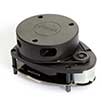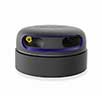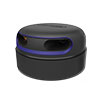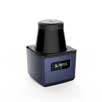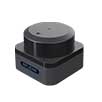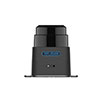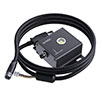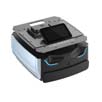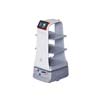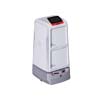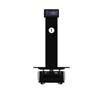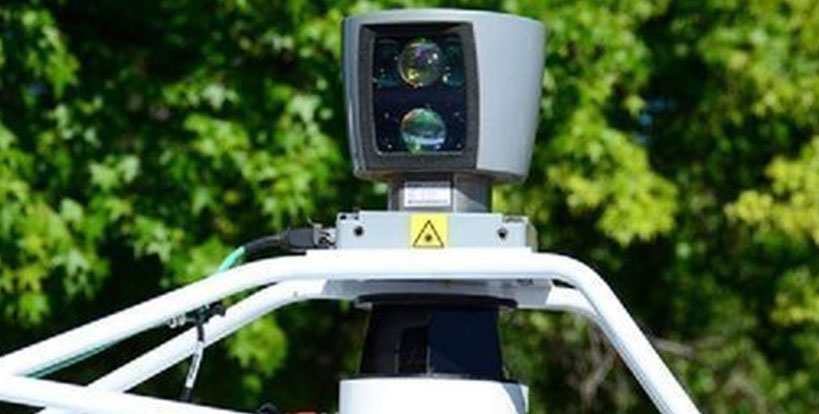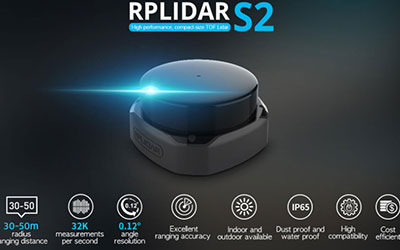Abstract: Industry demand acts as an alchemical furnace, refining LiDAR into a perceptive “all-seeing eye.”
Introduction: Digitization and intelligentization are comprehensively reshaping industrial production processes, leading to the emergence of numerous dark horse enterprises in the field of intelligent manufacturing. Driven by the combined demands of industry and robotics, the application market for LiDAR, a sensing hardware terminal, demonstrates a potential market value exceeding hundreds of billions of yuan.
As Industry 4.0 advances, the concept of “robots plus” continues to penetrate various application fields. From traditional industrial manufacturing to emerging service sectors, and further into industries such as healthcare, education, and entertainment, the application of robotics technology is becoming increasingly widespread. However, one of the core factors affecting the price and output of robots, namely core components, has been slow to break through. Against this backdrop, numerous domestically developed autonomous technology enterprises have emerged, among which Shanghai SLAMTEC Technology Co., Ltd. (hereinafter referred to as “SLAMTEC Technology”) is one.
To this end, an industry interview was conducted with Huang Jueshen, co-founder and CTO of SLAMTEC Technology, to delve into the technological breakthroughs and challenges in the application of LiDAR and autonomous positioning navigation. Below is a distilled summary of the interview.

SLAMTEC Technology is a company dedicated to addressing the challenge of enabling robots to achieve autonomous mobility in unfamiliar environments. It provides key solutions in robotics, including laser radar (LiDAR) and navigation positioning.
Technological upgrades form the core competitive advantage
The development process of LiDAR products is not linear and does not adhere to a fixed progression from mechanical scanning to semi-solid-state scanning. LiDAR products are designed and produced to meet the diverse needs of different fields. Therefore, the coexistence of multiple types of LiDAR is the norm in the industry.
Currently, positioning and scene construction technologies on the market mainly rely on two radar technologies: visual LiDAR and laser LiDAR. The advantage of visual LiDAR in large-scale and complex scenes lies in its higher reliability in positioning and its ability to provide richer visual information. However, its disadvantage lies in its weaker perception of obstacles and susceptibility to light and environmental interference, making it difficult for robots to achieve autonomous obstacle avoidance and movement. Laser LiDAR, on the other hand, offers higher accuracy and stability and can directly scan obstacles. However, in environments with significant changes or large scenes, its positioning capabilities may be slightly lacking, and its cost is relatively higher.
Regarding how visual SLAM (Simultaneous Localization and Mapping) and LiDAR SLAM are applied in practical scenarios, Huang Jueshen, co-founder and CTO of SLAMTEC Technology, said, “SLAMTEC’s perspective is that we have always chosen mechanical LiDAR as the core foundation, combined with visual SLAM technology to meet the needs of special products. This solution has been used in customer scenarios for many years, and the demand for hybrid solutions is also increasing.”

Laser LiDAR plays a crucial role in the field of robotics and can be considered one of the core sensors for robots. In the early stages, products providing laser LiDAR for robots were primarily monopolized by German company SICK and Japanese company Hokuyo, with prices being high. Over time, SLAMTEC Technology introduced the first civilian-grade laser LiDAR, the “RPLIDAR A1,” in 2014. This product not only reduced the price and cost of laser LiDAR but also enabled the mass adoption of robots in the industry. Huang Jueshen stated, “The A-series and S-series laser LiDARs developed by SLAMTEC Technology both utilize DTOF (Direct Time-of-Flight) technology. This type of laser LiDAR can achieve longer measurement distances and higher sampling frequencies. This makes it possible for AMRs (Autonomous Mobile Robots) in service robots and industrial robots to be widely adopted on a large scale, while significantly reducing industry costs and barriers to entry.”

SLAMTEC LiDAR Series Products
“We see that currently in the industrial sector, the widely used type of LiDAR is mechanical LiDAR. However, due to issues such as bearing aging and dust accumulation, most mechanical LiDARs have been overtaken in the market by solid-state LiDARs due to scene requirements,” said Huang Jueshen. “SLAMTEC Technology is able to achieve reliable operation with mechanical scanning, mainly due to its high reliability and long lifespan.”

Traditional mechanical LiDARs are prone to wear and fatigue due to continuous high-speed rotation and vibration during operation, resulting in a relatively short lifespan. To address the issue of short lifespan in mechanical LiDARs, SLAMTEC Technology has innovatively designed an optical-magnetic fusion technology. By combining optical and magnetic principles, this technology enables LiDARs to operate without contact and without wear. This innovation eliminates the wear and fatigue issues present in traditional mechanical LiDARs, thus extending the lifespan of the LiDAR. Additionally, SLAMTEC has continuously optimized and iterated its LiDAR sensors to overcome the challenge of inaccuracies when facing dark, small, or highly reflective objects such as glass surfaces. Furthermore, SLAMTEC Technology has also addressed interference challenges such as tailing and noise that arise in LiDAR applications, allowing the LiDAR to perceive every detail in the environment and provide better guidance to robots.
“SLAMTEC Technology has recently launched SLAMkit. From a hardware perspective, it mainly consists of a LiDAR, a positioning coprocessor module, and authorized software programs. For customers, they only need authorization to enable mapping and positioning capabilities on their computing platforms, simplifying the intermediate processes of research, testing, and adaptation,” said Huang Jueshen. He added that SLAMkit represents a completely new and highly valuable product form in the industry.

Industrial layout enhances brand driving force
When discussing the construction of a robot’s mobility, it’s crucial to focus on two core elements. Firstly, there’s the robot’s visual capability, which refers to its ability to accurately perceive obstacles and other information in its environment. Secondly, there’s the robot’s cognitive function, which involves making decisions based on the perceived information. Huang Jueshen said, “As an upstream player in the industry, we always prioritize the development of these two aspects and categorize our product line into two major categories: one is the ‘eyes’ of the robot, namely the LiDAR product line, and the other is the ‘brain’ of the robot, namely the navigation positioning solution product line.”
The perfect combination of these two products is SLAMTEC’s robot chassis product. Standardized chassis products are complex systems that integrate multiple disciplines. They encompass touch technology, mechanical structures, hardware, battery power management, as well as optical and navigation positioning technologies. Integrating these complex technologies and concepts into a complete machine production process is a challenging task. SLAMTEC Technology has introduced a series of standardized robot mobility chassis products, integrating sensors, navigation algorithms, product structures, batteries, hardware equipment, and software to provide robots with mobility, power management, and cloud-based remote implementation and control capabilities.
Most robots on the market have high hardware configurations because of the lack of software coordination during system construction, which requires more resources. For robots, only through coordinated software and hardware, optimized algorithm systems, and infrastructure designs can higher computing performance be achieved while consuming fewer resources. Take AGV robots as an example; they typically have two mainboards. One board is responsible for the robot’s core algorithms, such as motion optimization and control, using an Intel X86 processor, while the other board is for user interaction, using an ARM processor. Huang Jueshen stated, “SLAMTEC Technology has achieved the use of a single low-cost ARM mainboard to simultaneously run algorithms, user interactions, and better positioning performance, giving us a significant advantage over competitors.”
Regarding software design, Huang Jueshen believes that ROS (Robot Operating System) as an academic software platform is elegantly designed, but its engineering level and operational efficiency are relatively low, and it requires high memory and CPU demands. To address this issue, SLAMTEC Technology has independently designed a basic software platform called RoboStudio, which is not based on Android or ROS. “The ROS ecosystem is thriving, and some customers have demands for it. Therefore, the RoboStudio software system will also provide compatibility with ROS,” said Huang Jueshen.

For robot enterprises, it’s essential to have a dual strategy, providing both robot mobility and power management capabilities, as well as cloud-based remote implementation and control capabilities, to assist customers in achieving their goals effectively. This platformization model allows users to make autonomous adjustments based on their actual needs and scene requirements to adapt to real-world application scenarios. Such a design philosophy aims to provide users with a more flexible and personalized user experience while also enhancing system adaptability and scalability. Huang Jueshen mentioned that the platformization of robots is similar to the platformization strategy of automobiles. A single automotive platform can launch a series of different car products by making minor adjustments to the platform to meet the needs of different products, thereby designing, producing, and technically varying models.
Expanding abroad to enhance corporate influence
As a core sensor for robots, setting industry standards for LiDAR technology is particularly important. SLAMTEC Technology actively collaborates with other companies in the industry and national departments to lead or participate in the development of multiple LiDAR-related standards. Furthermore, as one of the earliest companies to provide standardized interfaces for LiDAR, SLAMTEC’s designed LiDAR and software interfaces have become industry implementation standards. Huang Jueshen expressed, “We are pleased to see that the interfaces designed by SLAMTEC have become a major industry standard. We also hope that our peers can launch even better products based on this foundation to meet the needs of customers.”
As one of the earliest domestic manufacturers engaged in LiDAR production, SLAMTEC Technology enjoys a high brand influence in overseas academic circles and enthusiast markets. Currently, over 30% of SLAMTEC’s annual revenue comes from overseas markets. Since last year, SLAMTEC Technology has established overseas branches in Singapore to better serve international customers. Leveraging a wealth of fully domestically developed intellectual property and components, SLAMTEC Technology is rooted in China and oriented globally, using branches like those in Singapore as overseas hubs to further expand into international markets. Huang Jueshen remarked, “From the current situation, the growth prospects for overseas markets next year are very promising.”
In the future, the performance and reliability of LiDAR systems will continue to improve, and it is believed that the market demand for LiDAR technology will also further increase. It is hoped that SLAMTEC Technology can continue to introduce competitive products and services, making greater contributions to the prosperity and development of the robotics industry.
The article is from the Robotics Industry Magazine titled “SLAMTEC Technology: The ‘Geppetto’ in the LiDAR Industry.”

